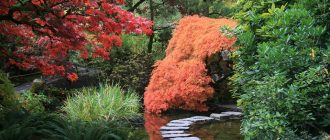Find out how the concept of Japanese water gardens evolved over time and why they continue to have the same mass appeal today…
The concept of Japanese water gardens has bemused the people of the 21st century. This blast from the past has come back into trend as the ultimate means of decorating your garden. Finding its origins in ancient Japanese history the art form is gaining world wide popularity today due to its timeless aesthetic appeal.
Tracing back the history of Japanese water gardens we find that their development took place over three main periods. The concept started to evolve during the Heian period 785-1184. Buddhism played a key role in the evolution of this concept as water gardens were considered to be a symbolic representation of paradise on earth.
The post Heian era saw Zen Buddhism exerting its influence on Japanese society which preaches simplicity. The change during this era was to represent nature rather than imitate it. Another important change that was taking place was regarding the quantity of water used within the Japanese water garden which was greatly being reduced. There were however certain revolutionary garden designers during that time that reintroduced the use of water in the Japanese garden design.
The method and systematic approach with which the Japanese approached the designing of water gardens was unparalleled by any other culture at that time. The precision and aesthetic sense that the Japanese possessed with regards to working with water, its flow, direction, placement of rocks and their innate symbolism was remarkable. Their artistry seemed as representing the principles of paradise on earth.
Zen water gardens
Things changed when the idea of Zen Buddhism took over people’s lives. The affect of the Zen philosophy was apparent in the change that took place in the designing of Japanese water gardens. Entire mountain ranges were now being depicted with small rocks. The use of water was replaced by the use of raked sand to represent water instead. Trees too were replaced by rocks and forests by flowers in an attempt to create a meditative environment.
There was a revolutionary change that took place in the designing of Japanese water gardens with the birth of the Japanese tea ceremony. It was this concept that revolved deeply along the teaching of Buddhism and the most significant developments in water gardens were made during these years.
After this era much of the Japanese gardens were inspired by the days gone by and there were no revolutionary changes being made to the concept of Japanese water gardens. Even the contemporary use of Japanese water gardens revolve around simplicity, enlightenment and the clarity of body and mind.
Irrespective of whether people take the suggested meditative implications of Japanese water gardens seriously the fact of the matter is that they are gaining popularity. New times have brought with them some additions to the aesthetics.
Today’s Japanese water gardens often feature eight narrow wooden bridges. Furthermore different stones, stands and lanterns are used as focal points within the garden. The use of moss is also a modern day addition seeking means of representing the ancient poetic traditions of Japanese culture.





